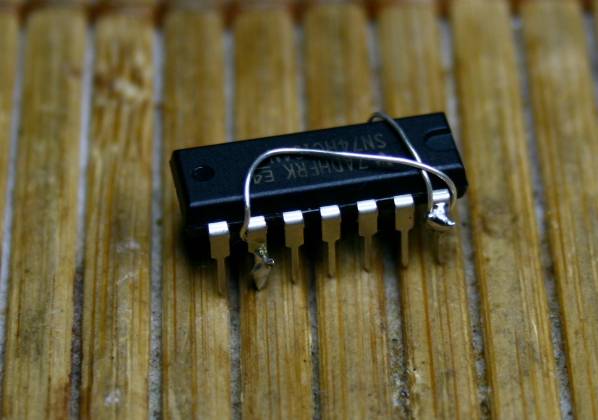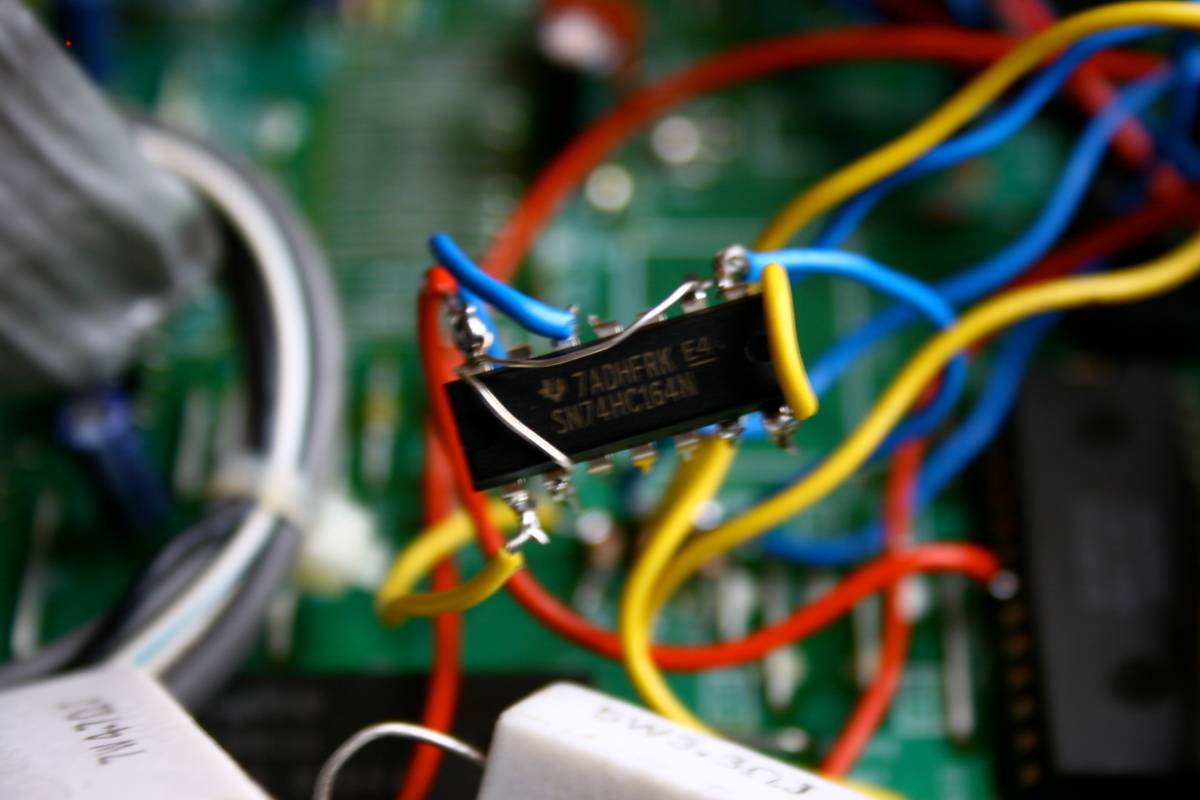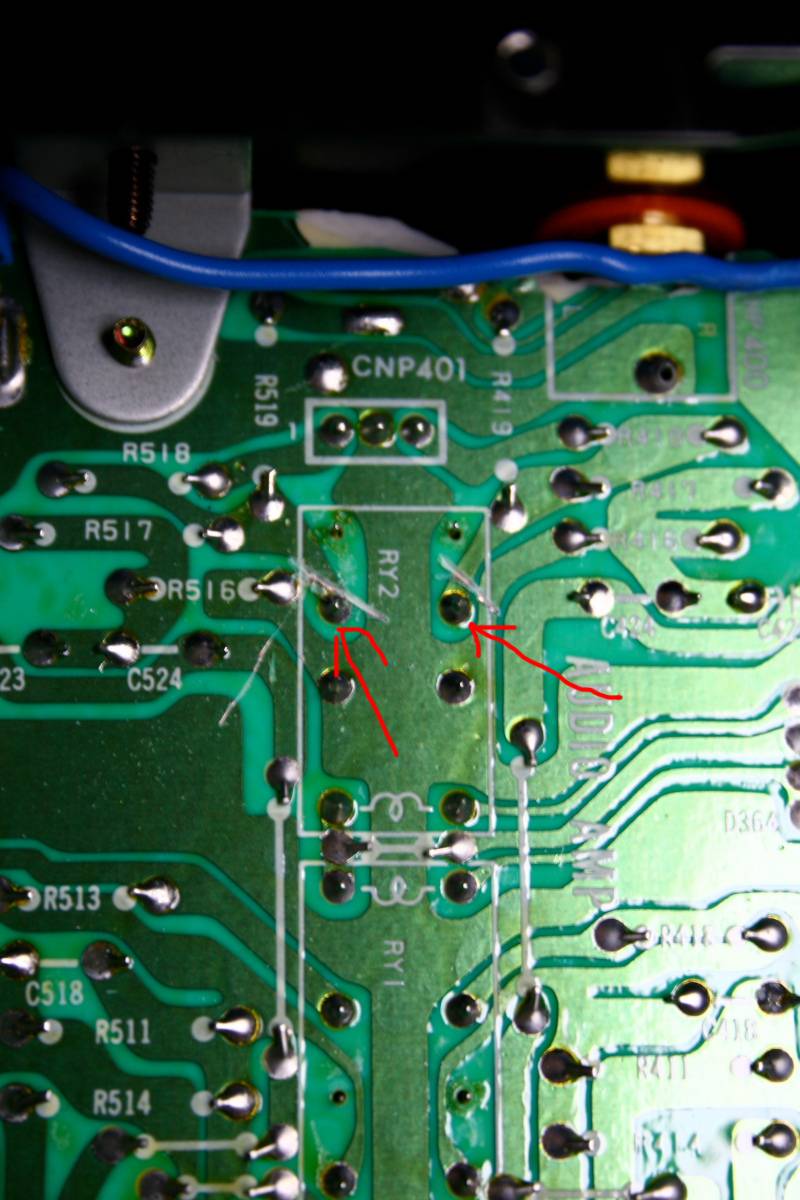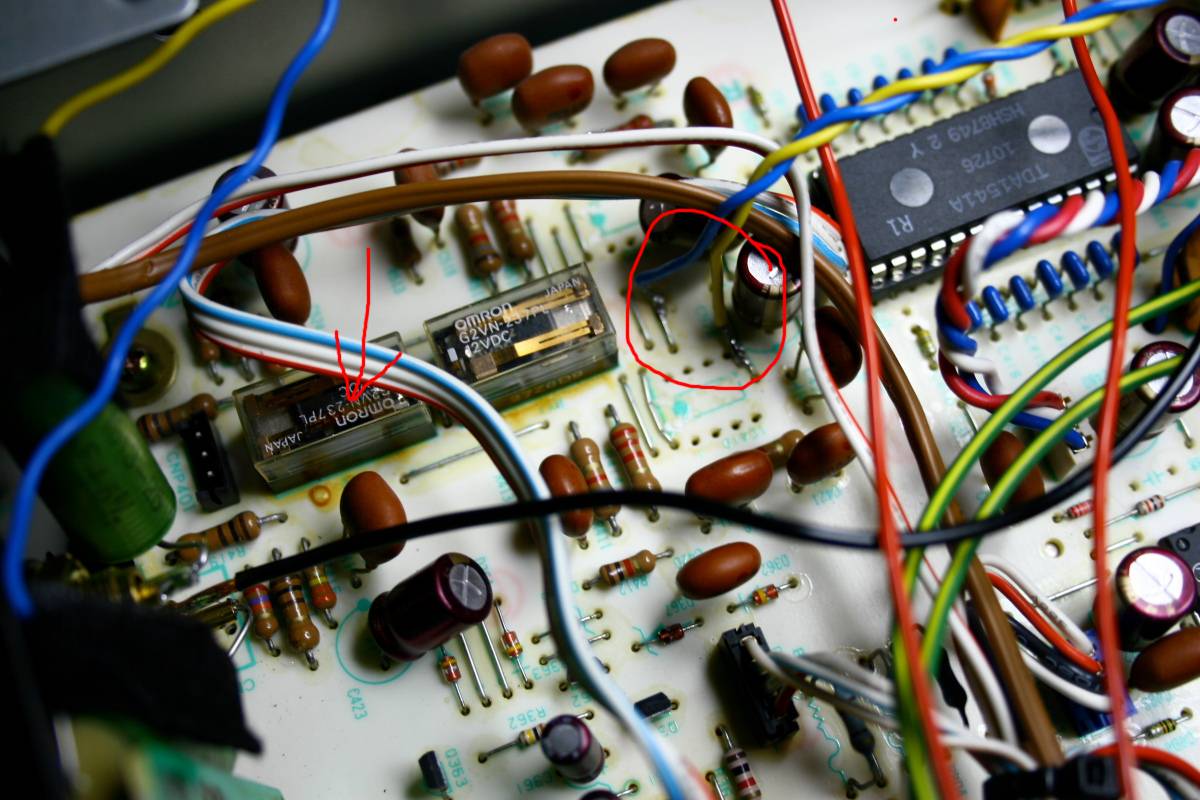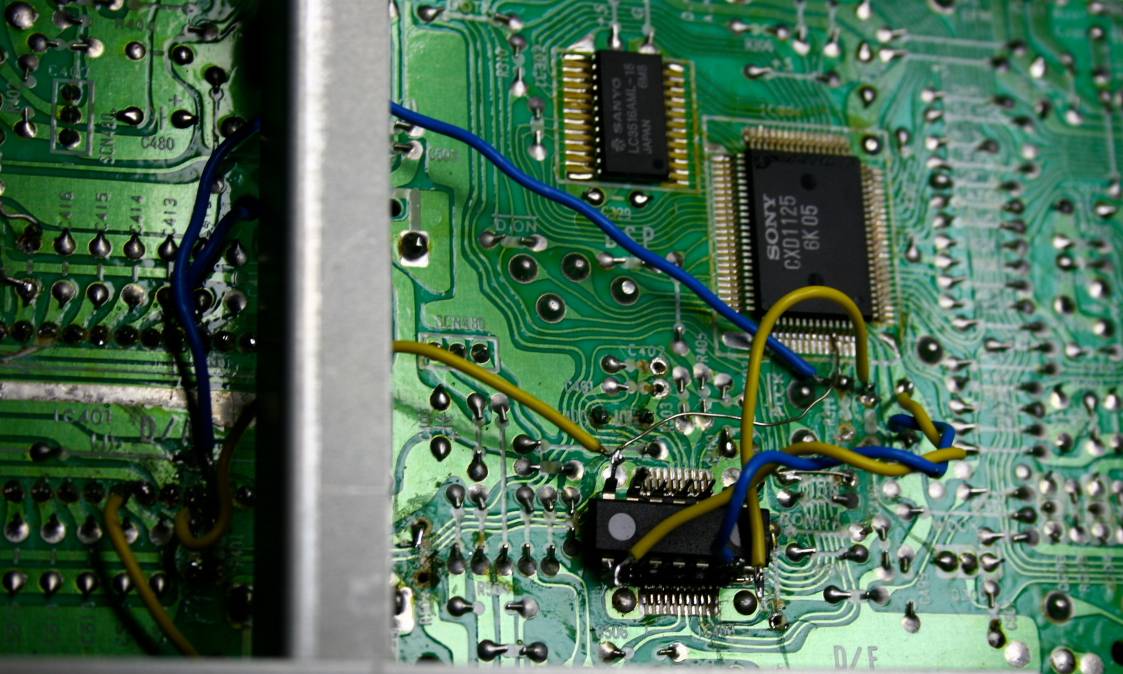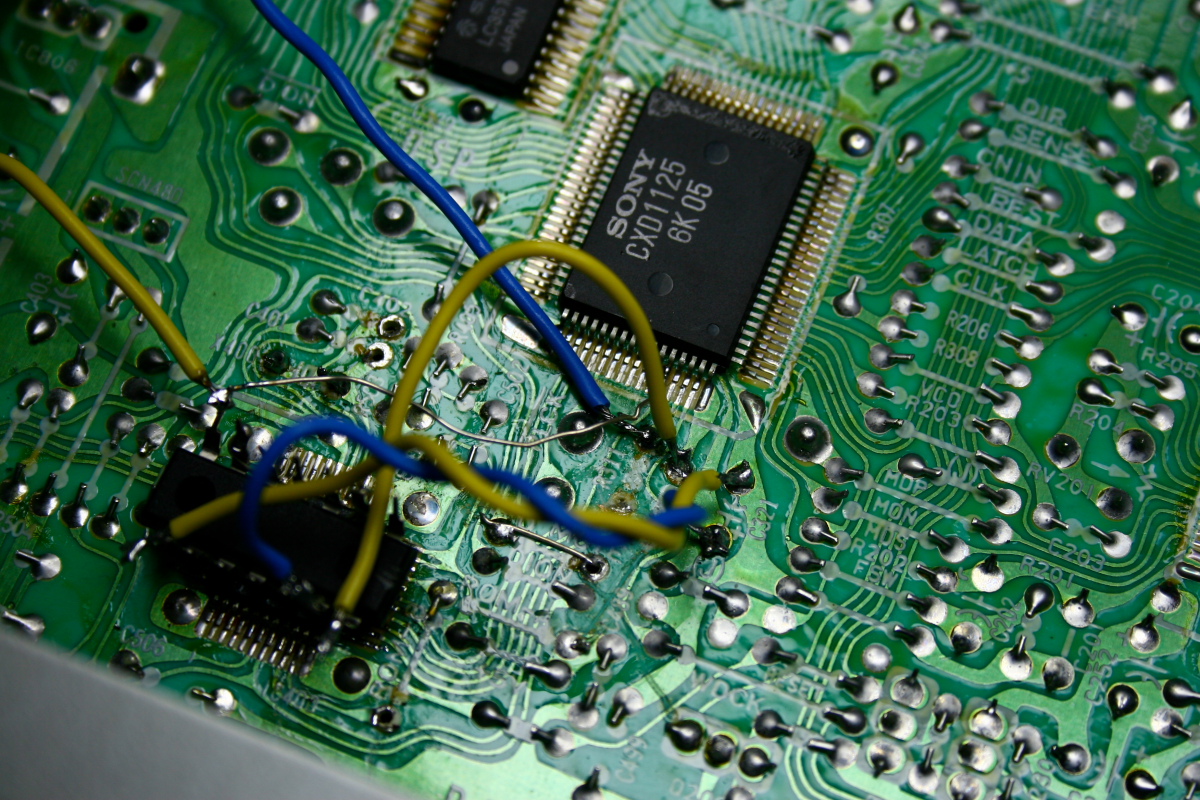Sony
CDP-333ESD
Lampized in
November 2008
Sony CDP-333ESD
I thought that I
know them all - the Sony range of players based on
TDA1541 DAC chip which they bought from Philips. Rightly at that time
they considered it to be the best DAC around.
The look, feel
and ergonomy is similar to the whole ESD range I have
nothing to say about the face plate that I haven't said already,
writing about the Sony 710, 222, 227, 338, 307, 507, 555, and
557.
The CDP333ESD is
almost the ideal optimal Sony - with top mechanism
(BU1-KSS190A) and with top DAC. It is only bettered by the
337ESD which has two dacs. Otherwise - nothing beats the 333. Not even
the 557ESD. If you can find it - GET IT, If you own it - hold on
to it.
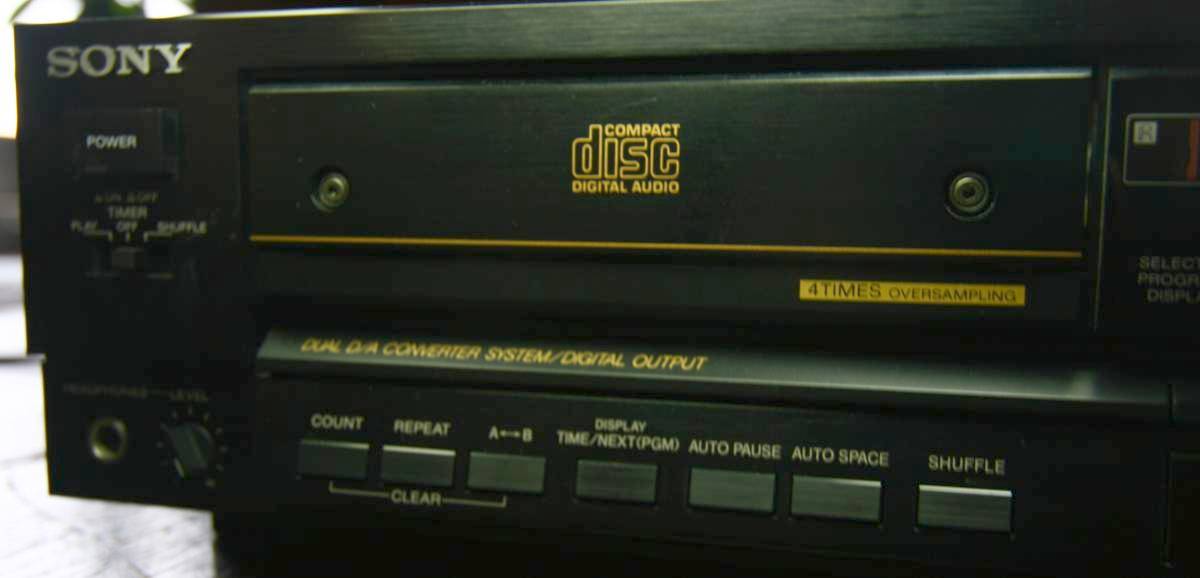
Please note the
4 times oversampling. Thank God - not 8.
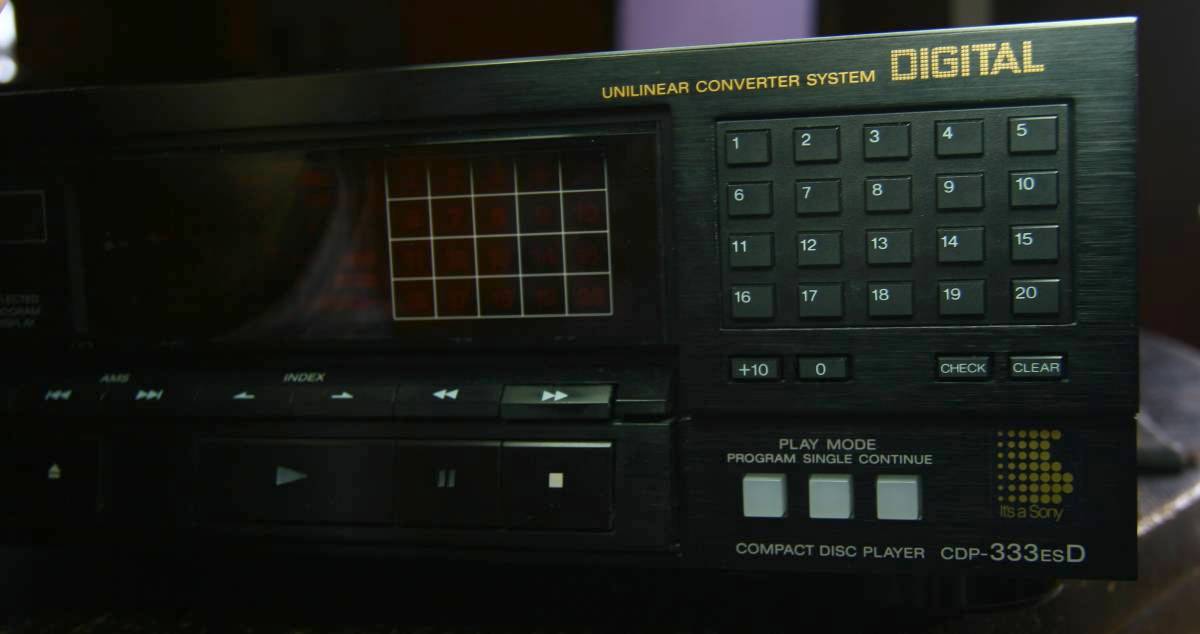
I never heard
before that someone called the TDA1541 like "unilinear"
but what the hell.
Lampizator installation inside Sony CDP-337ESD cd player
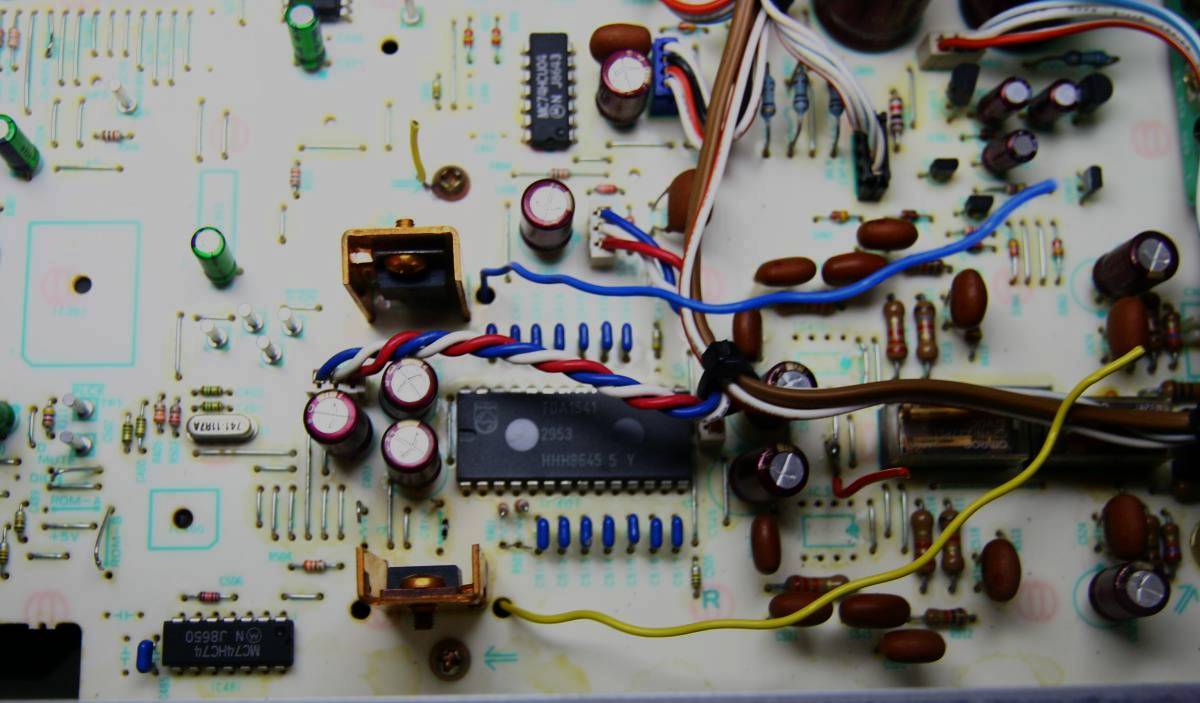
In this
application the TDA is Non-A type, non-s. The decoupling caps
are blue small MKP 100nF. The power supply is provided by DEDICATED
regulators (with copper radiators) and elna duorex caps. Only two
opamps in original PCB - but I removed them to reduce power
consumption. overall very nice design.
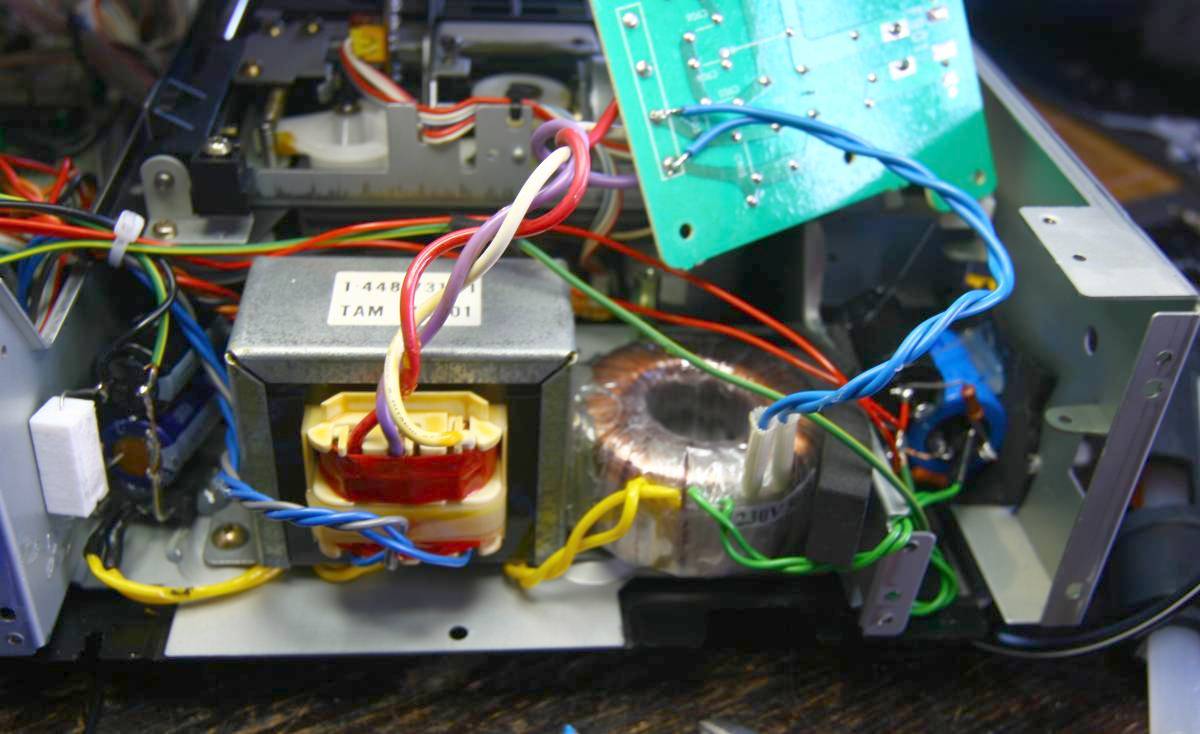

I was lucky to
find the empty space for the Lampizator transformer.
After removing the AC input PCB - there is ideal space. On the right
you can see the heater DC supply hiding in the empty cavity.

Note the AC
stealing points for lampizator. The point is after switch,
after noise filters, after fuses.

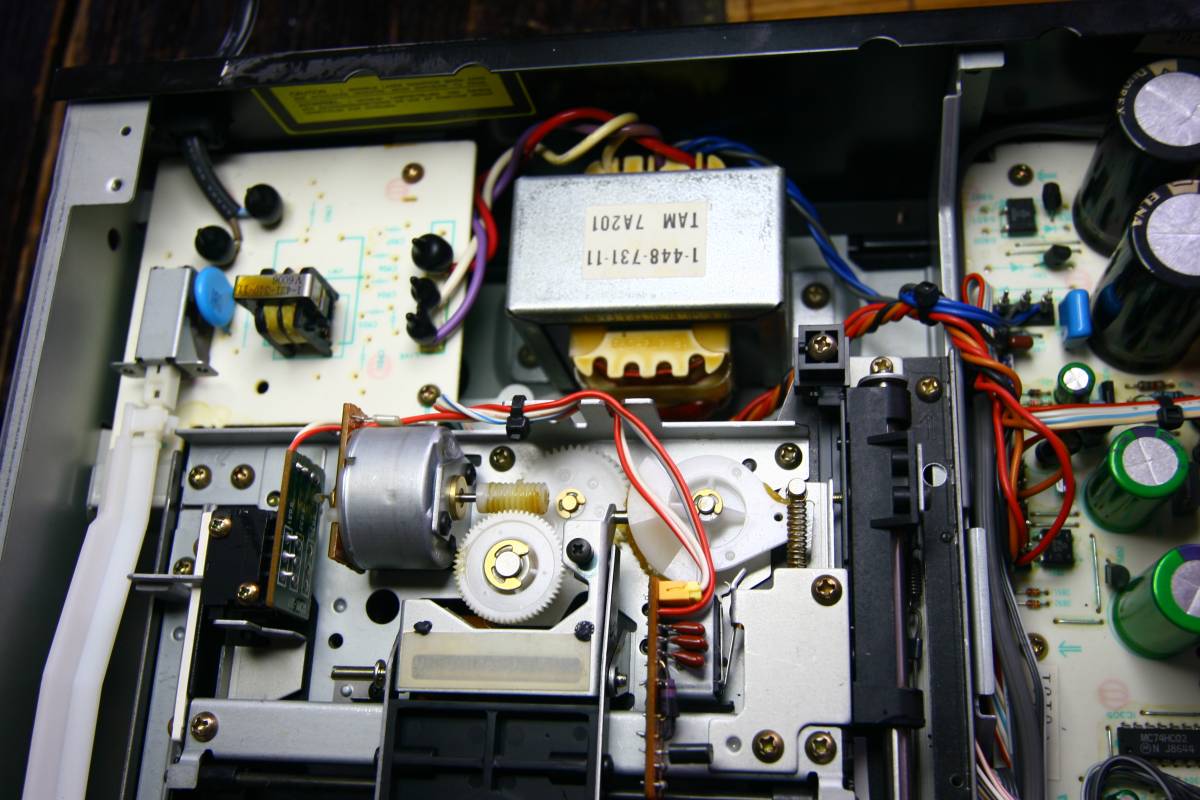
The top view of
the KSS mechanism (all 100% metal) and in the top
left corner - the INVISIBLE transformer and PSU of the lampizator
under the white PCB of AC Power inlet.
AC power has a
choke and MOV varistors. Very nice touch. The power
transformer is quite adequate.

General top view
with the count of 5 voltage regulators. The yellow and
blue wires steal music signal from DAC TDA1541 pins 6th and 25th. Ready
for tubes to arrive.

After I removed
the old quad of RCA's (oops I broke a piece of PCB) I
was able to install the new proper Gucci RCA's.
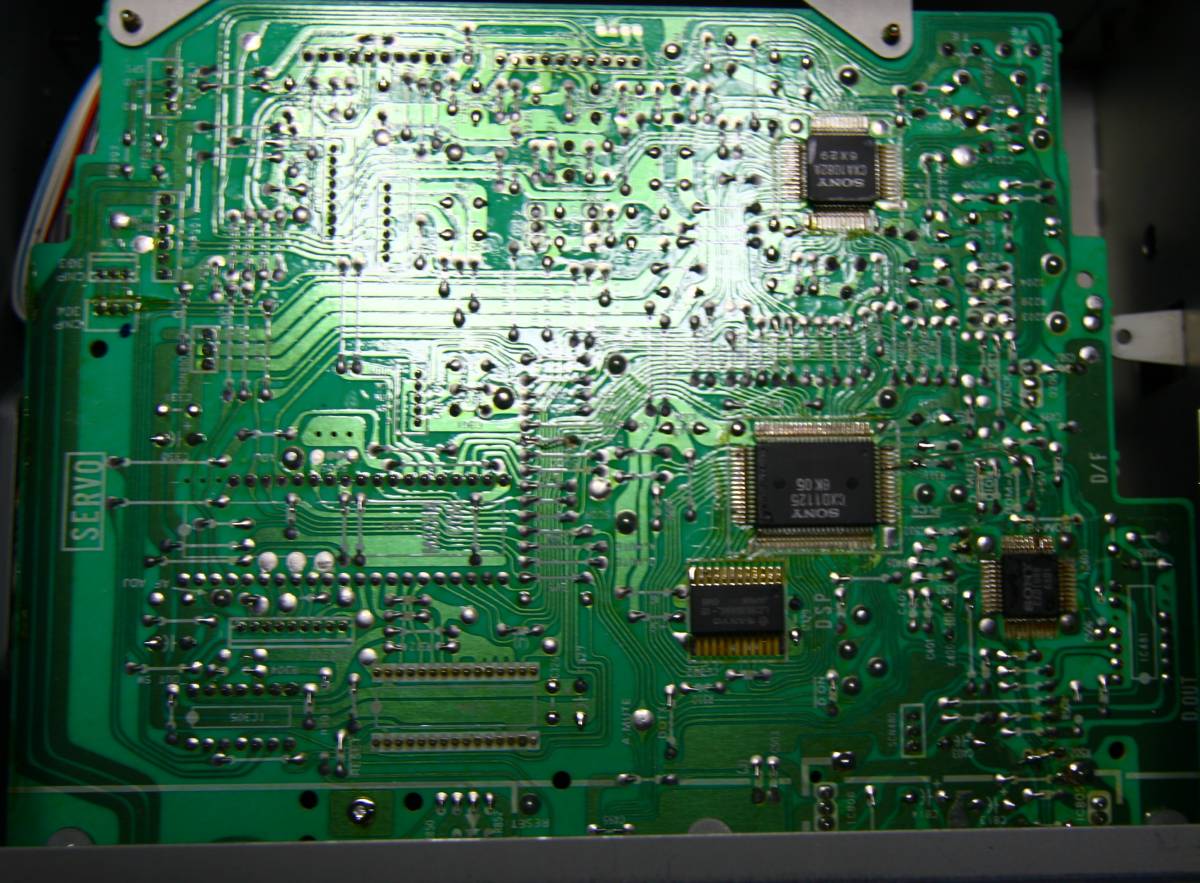
Usual Sony
chipset of SMD mount demodulator, digital filter and main
processor.
The power supply
has gigantic capacitors for raw supply filtering and
some MOV's too for protection from AC dirt and overvoltage spikes.
What is missing
is the good old ferrite choke on AC lines as well as
IEC cable socket. The AC cable is non detachable.
Also the
transformer is no longer screened, potted and encapsulated.
This player has
absolutely IDEAL place for my extra transformer. There
is an empty corner with comfortable mounting plate and easy
access to 220V stealing point (after power switch and after fuse).
Perfetto!
Lampizator
Just for a
change I decided to use octal tubes. I chose the 6sl7GT and
namely - the excellent Chinese production of 6N9P salvaged from the
Music Angel amplifier.
Again - just for
a change - I decided to expose the tubes and display
them proudly on top.
This octal
socket choice will allow the user to roll tens of different
western tubes like RCA or GE or Sylvania.
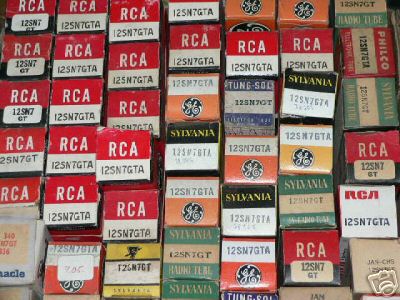
Having said that
- the ultimate octals are Russian metalbases 6H9C
In my setup,
also the 6SN7GT will fit as well as the redbases.
The circuit is
SRPP with 200 Ohm resistors and a 82 R grid I/U
converter.
Power supply is
150 VDC and current is circa 1,3 mA.
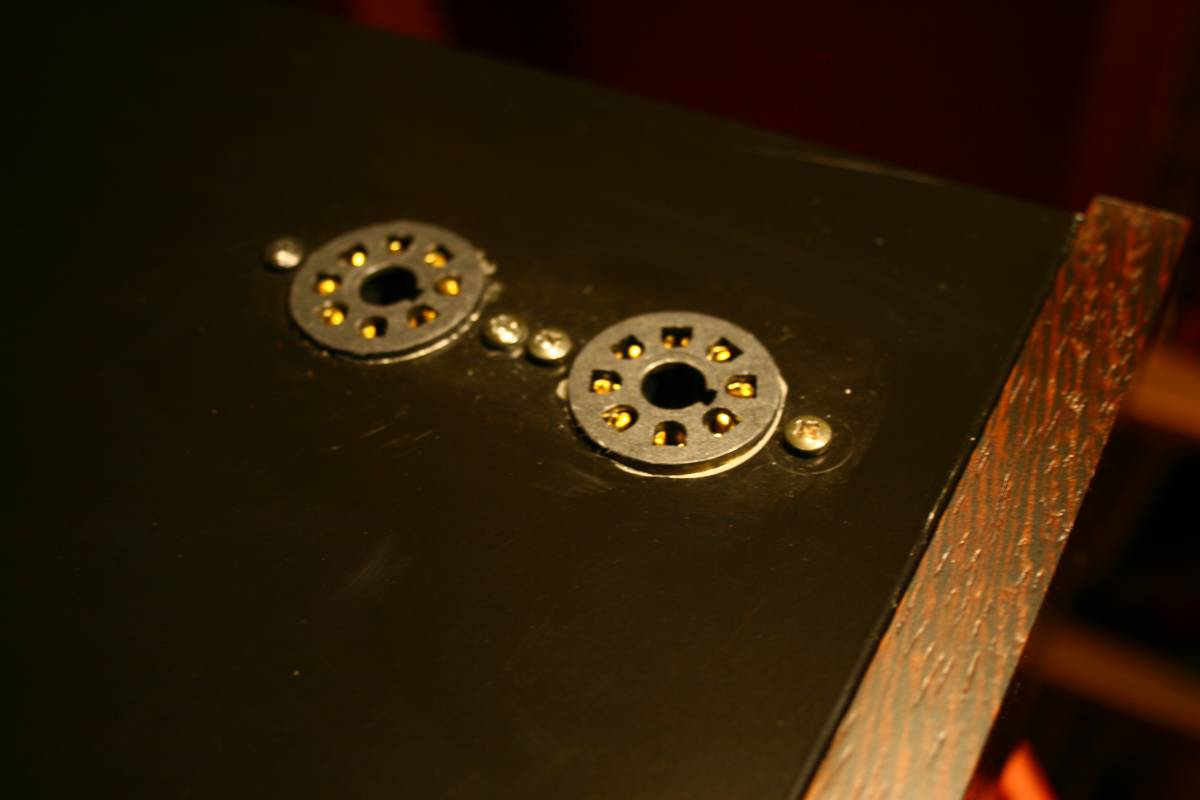

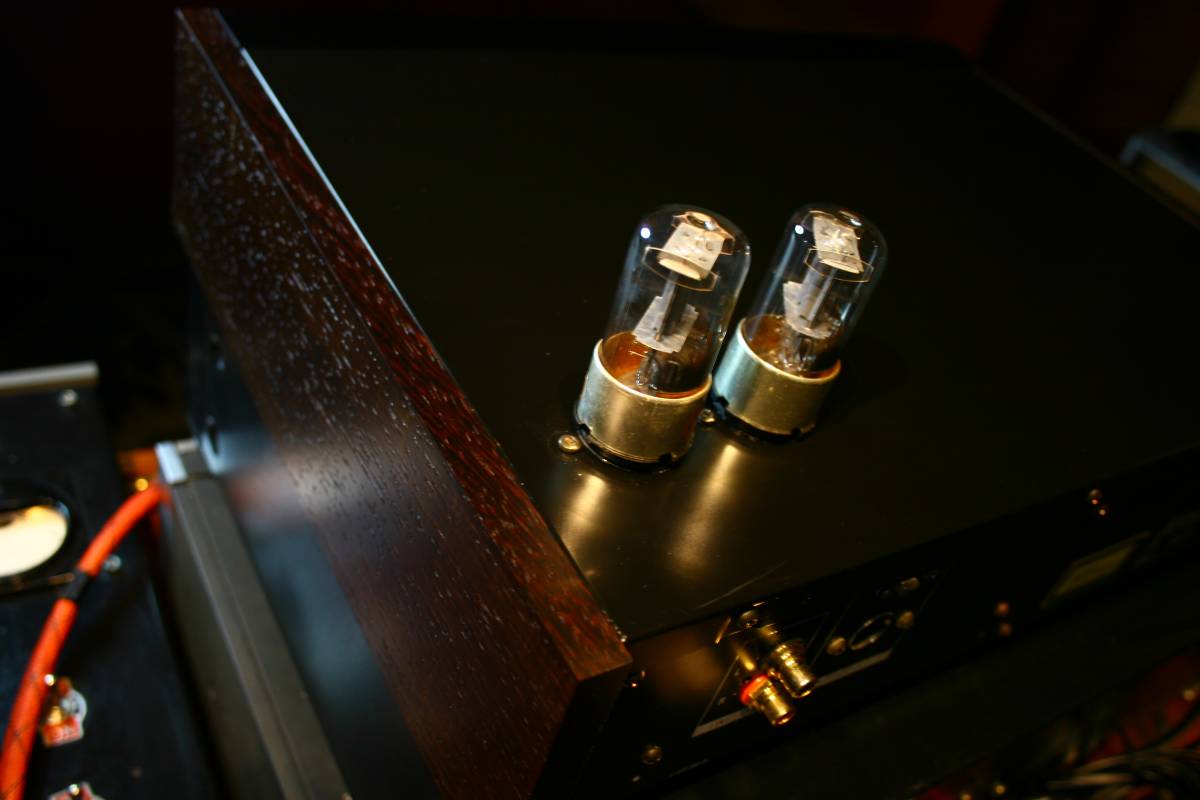


ZE SOUND
The stock Sony
CDP-333ESD is very nice, I like it a lot. It sounds
neutral and musical. I can not find any serious criticism of the stock
sound. The player has only one double opamp per channel.
After
lampization, it becomes a serious contender. I swapped it with
the Sony CDP-338ESD based on PCM58 and I could not really detect a big
difference. The players are in the same league. After a week of
swapping - my preference is TDA based 333ESD. The PCM58 player is very
very very close, maybe a touch colder.
This player
could make absolutely top notch transport, especially after
SP/DIF tweaking.
Now I wish I
could make the player a NOS. That would be interesting. I
haven't managed to do this yet despite many hours wasted to do
it.
Strongly
recommended.
SONY
November 30 2008
SENSATIONAL discovery of NOS mode
NOS for the SONY CDX1088 digital filter
The Sony players like CDP-555ESD , and some others like Nakamichi
CDP2-e do not use the SAA7220p/B but instead they use Sony CDX1088
chip.
It basically works the same as the Philips, but it is SMD hence it is
hard to solder to its legs.
The CDP-555ESD
has 4
times oversampling applied inside the chip that precedes the Philips
DAC
TDA1541, which is SONY CXD1088. We can identify the pins which carry
I2S signals and bypass the chip by means of a bridge of 3 wires a'la
Philips
7220p/B. BUT..... the sony chip is so small and it is SMD that the
soldering is too difficult for me. Even with 10 x magnifying glass and
a sharp soldering tip I am unable to do it properly.
The tracks leading to and fro this SONY 1088 chip have no other points
where I could tap to them. The only possible scenario is to solder to
chip legs.
I thew the towel. Sorry. Maybe I will try one day again.
A month later I decided to try
it. I chose Sony CDP333ESD and I bridged the I2S signal over the
CXD1088 . The rersult was a mixed bag - there was sound audible only at
MAX amplifier volume. So the player played OK, but it was somehow
muted. I found 3 different MUTE pins on three chips around. I
experimented with isolating, floating, grounding of these pins - and no
success. The music was audible but probably -60dB. I gave up untill
someone tells me where I went wrong.
November 2008
Thanks to the power of internet, I got some help from very kind pen-pal
Mr. Avinash. He suggested a digital trick which basically changes the
internal data protocol betweek SONY chips wihich preceed the TDA1541
DAC.
Here is what he says:
I thought I would let you know that I
have now successfully made the NOS mod to the Sony CPD 227ESD. (L.F.
> It is also directly applicable tyo Sony 950, 710, 337ESD, 333ESD
ESD, 555 ESD, and probably also to the Nakamichi CDP-2e)
The
main issue to solve is that the output of the Sony DSP chip CXD1125 is
in the Sony/EIAJ format and not the Philips I2S format. The easiest way
to convert the Sony format to the I2S format is to delay the LRCLK
signal by 7 bit clock pulses and swap the analogue outputs of the
TDA1541A so that what was previously the Left channel ouput becomes the
Right channel and vice versa. BCK and DATA can simply bypass the
CXD1144P filter chip.
I used a 8 bit serial in, parallel
out (SIPO)
shift register (74HC164A) chip which costs about 20p in the UK. The
input to the chip is the LRCLK signal from the CXD1125 chip and I used
the 7th bit as output to the two TDA1541A's. You also have to take a
parallel BCK signal to this chip as well as +5V (taken from the
CXD1125) and ground. If you take a look at the datasheet, copy
attached, you will be able to see how it works.
This gives full volume (and full
resolution) on the analogue outputs of the TDA1541A.
I
was getting some noise when the CD player was not playing any CD's but
this goes away if you switch the Digital Out at the back of the CD
player off.
The sound out is analogue like and
flowing very much
like other NOSed TDA1541A CD players but the 227ESD also appears to
have better resolution and clarity. It is a little bit better then my
NOSed Marantz CD40 to my ears.
I am listening to it right now and it
is sounding very good!!!
The pin connections I used on the
74HC164A are:
Pin 1 - LRCLK from CXD1125 taken from
before R540 connection with R540 leg lifted - input clock
Pins 2,9,14 - +5V from Pin 8 of
CXD1144P supply line
Pin 7 - Ground
Pin 8 - BCLK from before R542 with
R542 leg lifted.. Same signal goes to both TDA chips leg 2 and 2.
Pin 12 - Output LRCLK to the
TDA1541A's legs 1 and 1 parallel. - left-right switch clock
The remaining DATA signal goes from any of the R541 sides of
resistor to both legs 3 of TDA1541 paralleled,
All other pins of the 74HC164A are unused.
This already plays FANTASTIC music but makes some noises on pause.
From Lukasz:
There will be garbage noise when CD is on pause or skipped to next
track.
The mute remedy is analog relay mute which used to mute the old signal.
We must find the output relay - the black box near old RCA ouitputs. We
connect the relay's legs marked NO to the RCA outputs.
Before that we must float these relay legs which used to go to old
outputs. During mute period the relays will ground the signal.
The mute works well for no play period, for play period, for fast
forwart and backward too. Only for the track skip there will be 1/10 th
of a second of unwanted signal. Small problem for a great improvement
overall.
The sound does improve a LOT. It jumps to the next upper class of
playback systems.
Strongly recommended.
In Sony CDP-333ESD with one TDA and CXD1125 demodulator and typical
digital filter CXD1088
we go like this: the whole job is done on the bottom of the PCB.
data goes straight from CCD1125 leg 78 (lift R311) to TDA pin 3
(floated)
BCLK goes from pin 76 of the 1125 (trace it to the first breaking point
- a jumper or resistor and then float it by lifting that part) to
the pin 8 of the 74HC and from there straight to TDA pin 2
(joined with 4 and together - floated)
LRCK goes from pin 80 of the
1125 (trace it to the first breaking point - a jumper or resistor and
then float it by lifting that part) to the pin 1 of the 74HC and
from pin 12 (output of 74HC) to TDA pin 1 floated.
FROM THE DATASHEET:
MC74HC164AD - 8-Bit Serial-Input/Parallel-Output Shift Register
High–Performance
Silicon–Gate CMOS
The MC74HC164A is identical in pinout to the LS164. The device inputs
are compatible with standard CMOS outputs; with pullup
resistors, they are compatible with LSTTL outputs. The MC74HC164A is an
8–bit, serial–input to parallel–output shift
register. Two serial data inputs, A1 and A2, are provided so that one
input may be used as a data enable. Data is entered on each rising edge
of the clock. The active–low asynchronous Reset overrides the Clock and
Serial Data inputs.
• Output Drive Capability: 10 LSTTL Loads
• Outputs Directly Interface to CMOS, NMOS, and TTL
• Operating Voltage Range: 2 to 6 V
• Low Input Current: 1 mA
• High Noise Immunity Characteristic of CMOS Devices
• In Compliance with the Requirements Defined by JEDEC Standard
No. 7A
• Chip Complexity: 244 FETs or 61 Equivalent Gates

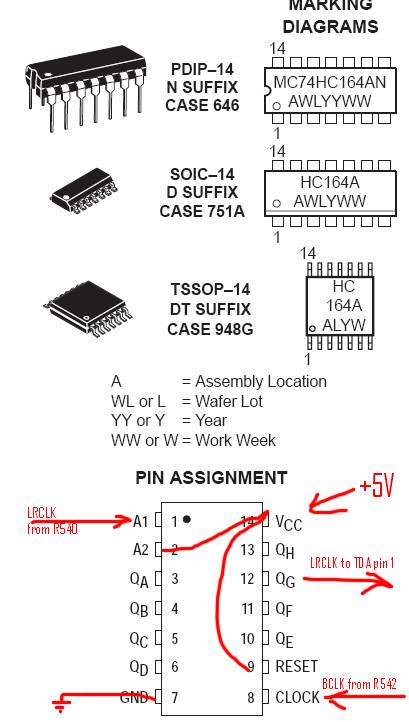
DATASHEET:
http://pdf1.alldatasheet.com/datasheet-pdf/view/12165/ONSEMI/MC74HC164AD.html
SONY family of ESD players in Non Oversampling mode (NOS)
after experimenting with my two players from that family - namely
CDP227ESD and CDP333ESD i draw a conclusion.
1. TDA1541A is a hell of a dac, its full potential is unlimited.
2. The Sony NOS implementation is better than Philips one, to be found
in Grundigs, Marantzes and Philipses. The difference must lie either in
the laser mechanisms (227 uses KSS151A and 333 uses a better (best)
KSS190A or BU1. Or it lies in the fantasttic sony demodulator chip -
the one which converts laser impulses into proper digital format
datastream. Or the difference is a sum of the two above. Anyhow - the
sound coming from NOSed and lampized ESD players is totally awesome.
3. Two DAc chips in 227 do sound better than one in 333.
4. 6N2P is best tube I know today for this particular application (in
SRPP mode)
5. if you love MUSIC not HiFi - you can not find anything better
without financial constraints. I guarantee it.
It is very very hard to impress me with all my experience and
knowledge, I was not prepared that there may be such a giant quality
leap waiting to be unleashed.
Even SATCH dac, which theoretically is TDA at the limits - is inferior
to Sony in NOS mode. That is understandable - SATCH must use SP/DIF
process of transmission, and Sony is one box solution which does
without SP/DIF at all. All process is direct and very simplified.
As good as Sony 227ESD is on its own, as great as it is with
lampizator, after NOS - the sound is drop dead gorgeous. It re-defines
my quality ladder, all classifications of sound quality must be
downgraded to make room for this new whole class of quality.
The pleasure of listening goes up whole level, the amount of
information is beyond my wildest expectations. It is not about bass or
trebles, it is about the ease of understanding what is in the
recording. The details in background become so easily understandable,
the secondary instruments are miked anew. I hate to say the most
trivial sentence like "I heard things I never heard before" but that is
just that - all intimately known recordings become totally new
experience. On general note, all aspects of reproduction become very
LOVABLE and right - timbre, colour, space, timing, voices are natural,
space is wiiiiidddeee, instruments clear, separated, audible. I cant
really describe it. It is far above my language skills to tell you how
good sound becomes.
From evetything I ever heard, the 227 ESD nosed is by far the best
sound. This is so good that I would say it is the end of the road.
Absolute lack of desire to try improvements. It is what I dreamed about
all my life. I cant even write about it anymore - I rest my case.
